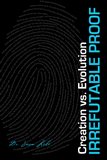A Review of the New Darwin Exhibition at the American Museum of Natural History
Gordon Franz, a Bible teacher, recently visited the large new Darwin exhibition on the third floor of the American Museum of Natural History (AMNH) in New York City.

I recently visited the large new Darwin exhibition on the third floor of the American Museum of Natural History (AMNH) in New York City (which AiG has already reported on at Darwin Still Debating the Creationists).
My tour through this dogmatically presented exhibition reminded me of a joke about a biology professor who gave a lecture to a university class on the evidence for evolution. In the margin of his lecture notes he had written in bold red letters, “Argument weak here … shout!”
Bold, dogmatic statements about evolution are made throughout the Darwin exhibition, such as:
- “The theory of evolution still persists today, much as Darwin first described it, and is universally accepted by scientists.”
- “Darwin’s theory of evolution by natural selection is the only scientific explanation for the spectacular diversity of life on Earth.”
- “Creationism, including Intelligent Design, does not offer a scientific alternative to the theory of evolution.”
- “Darwin’s theory of evolution by natural selection underlies all modern biology.”
The visitor to Darwin, after being bombarded with evolutionary propaganda, is left with the impression that everybody believes in molecules-to-man evolution and nothing else is scientific. Because some of the interactive exhibits are designed primarily for young people (e.g., one on homology; for a refutation of homology as a branch of science that supports evolution, see “Similarities Don’t Prove Evolution”), it is particularly sad to see this indoctrination foisted on the most-impressionable of museum visitors.
Each showcase and display is well laid out and meticulously labeled. There are many pictures, charts, maps and diagrams that illustrate the historical impact of Charles Darwin’s life and his theory of evolution. One can even view a reconstruction of Darwin’s study from his home (called “Down House”) in England, and the actual magnifying glass he used to examine some of the plants, animals and insects he collected on his voyage around the world on the H.M.S. Beagle.
Some of Darwin’s original manuscripts and notebooks, in his own handwriting, are also on display, as well as the fossils he collected on his historic voyage (along with the Bible that Darwin took with him on the Beagle!). There are also live exhibits of an iguana, horned frogs and Galapagos tortoises, animals related to Darwin’s naturalist studies.
As I walked through the exhibit, I quickly picked up another agenda of exhibit organizers. The exhibit was not just pro-evolution, but was a deliberate attempt to cast creationism and Intelligent Design as religious and not scientific. Only evolution was presented at the AMNH as scientific. There is a condescending attitude toward Bible-believing Christians throughout the exhibition.
There are a number of factual errors and misleading statements. For example, the exhibition attempts to give evolution credibility by comparing it with the “theory” of gravity. But gravity is more than a theory; it is a well-established law of nature and can be directly observed and repeated in the present—unlike evolution. (By the way, the exhibition does not deal much with the fossil record, the supposed proof of molecules-to-man evolution.)
Vestigial organs, those structures that appear to have no useful function, are shown to demonstrate “the evolutionary histories of species.” For example, five “human vestiges” are displayed on a diagram of the human body. They are the “erector pili [muscles that cause goose bumps], body hair, coccyx (tail bone), wisdom teeth, [and] appendix.” These “vestiges” do have functions in the human today. For example the appendix is useful, especially early in life, to protect the body against germs where the food moves slowest in the intestines. [For a refutation of vestigial organs as an argument for evolution, see “Do Any Vestigial Organs Exist in Humans?”]
The museum presents two major experiences in Darwin’s life that left a profound impact on him. The first was the voyage on the H.M.S. Beagle, which Darwin described as “the most important event in my life.” The second was studying under Rev. J.S. Henslow, professor of botany at Cambridge University in England, which Darwin stated “influenced my career more than any other.”
Next to a map of the world that showed the route the H.M.S. Beagle took is a list the places visited and what was accomplished at each stop. The entry for Tierra del Fuego (December 1832) says, “Captain Robert FitzRoy repatriates three native people he had brought to England on a previous voyage; he attempts to start a Christian mission, which fails disastrously.”
When I returned home after visiting Darwin I had a conversation with a Christian biologist who related the “rest of the story” about Capt. FitzRoy. Eventually his mission did succeed and Darwin contributed financially to the mission organization because the Fuegians, whom Darwin had previously considered to be “anthropological intermediates” (i.e., not fully evolved as far as Western people), converted and changed their lifestyle. In fact, Darwin contributed to the South American Mission from 1869 to 1882. He even requested honorary membership in their society (The Life and Letters of Darwin, vol. 2, pages 306–308, edited by Francis Darwin).
One evolutionist in particular greatly influenced his thinking: his grandfather Erasmus Darwin. (Many people mistakenly believe that Darwin originated the idea of evolution, but evolutionary ideas existed back even into ancient Greek times; see the book The Long War Against God by Dr. Henry Morris.)
A few times the exhibition mentions that Darwin once studied for the clergy and that a few clergymen had profound effects on his thinking. Renowned geologist Rev. Adam Sedgwick, as pointed out by AiG’s Dr. Terry Mortenson in his book The Great Turning Point (pp. 110–113), did not believe in a young earth and universal worldwide Flood. One can only imagine the conversations that Darwin and Sedgwick had on their geological field trips in Wales and Scotland. Sedgwick is quoted in the exhibition as saying that after reading On the Origin of Species by Darwin, that it caused “more pain than pleasure.” Apparently, while they may have agreed on most things related to geology, the topic of biology, however, was another matter.
Another clergyman who influenced Darwin was Rev. Thomas Malthus, who was also a political economist. His famous book Essay on Population helped provide Darwin with the concept of natural selection or “survival of the fittest” (a phrase actually coined by Herbert Spencer).
Darwin’s mechanism of evolution—natural selection—is defined in the museum as “a simple mechanism that causes populations of living things to change over time.” The steps involved in this process are “variation, inheritance, selection, time and adaptation,” known by the acronym VISTA. As regular AiG web visitors know, natural selection explains the “survival of the fittest” but not the “arrival of the fittest.” AiG has set the record straight concerning natural selection in many articles.
In one section on natural selection, the museum attempts to make evolution relevant to today. Without Darwin’s theory, modern-day researchers (it is argued) would not understand the rapidity by which evolution supposedly occurs and thus they would be hampered in dealing with things like the avian flu virus.

The AMNH is a temple to evolution. Notice on this promotional brochure that a just-concluded AMNH exhibit on dinosaurs was making the claim that dinosaurs evolved into birds. (See AiG web articles that refute this dino-bird claim.)
As something of a doxology to evolution and of praise of Darwin, the exhibition’s final section celebrates the beauty and diversity of plants. Regarding the variety of orchids, the museum quotes Darwin: “From so simple a beginning, endless forms most beautiful and most wonderful have been, and are, being evolved.” An “amen” is almost expected at this point after spending so much time viewing several exhibits exalting Darwin and his theory. (For a creationist view of orchids, go to Orchids ... A Witness to the Creator.)
The Darwin exhibition at the AMNH will have a far-reaching effect on the creation vs. evolution debate. The exhibition will continue in New York City until May 29, 2006, [Since this article was posted, the AMNH announced that the Darwin exhibit will be extended to August 20.] and then will travel to the Museum of Science in Boston, The Field Museum in Chicago, the Royal Ontario Museum in Toronto and then its final display at Britain’s Natural History Museum in London 2009 (to commemorate the 200th anniversary of Charles Darwin’s birthday and the 150th anniversary of the publication of his On the Origin of Species). Already, the exhibition has received tremendous media coverage in the US over the past weeks (including a Newsweek cover story).
Unfortunately, the Darwin exhibition at the AMNH presents only one particular worldview as true. With its impressive, authoritative displays, a museum like the AMNH can be a highly influential tool in presenting the evolution viewpoint. This should be a challenge to creationists to build museums from a creation perspective. As John Rajca, the former curator of the ICR Museum of Creation and Earth History in San Diego, California, has declared, “There should be a creation museum in every major city in America.” Such centers, like AiG’s future Creation Museum near Cincinnati, Ohio, would be great educational outreaches for informing the public about the fallacies of evolution and the positive case for creation and the Creator, the Lord Jesus Christ (Colossians 1).
is a Bible teacher who has engaged in extensive research on the archaeology and geography of the Bible. He has participated on a number of archaeological excavations in Israel. Gordon is on the staff of the Associates for Biblical Research, and is active in the Creation Study Group of New Jersey (www.csgnj.org). While a student in the 1970s at Christian Heritage College in California (now called San Diego Christian College), he had the privilege of studying under leading creationists such as Dr. Henry Morris, Dr. Duane Gish, and Dr. Gary Parker.
Recommended Resources

Answers in Genesis is an apologetics ministry, dedicated to helping Christians defend their faith and proclaim the good news of Jesus Christ.
- Customer Service 800.778.3390
- © 2024 Answers in Genesis



